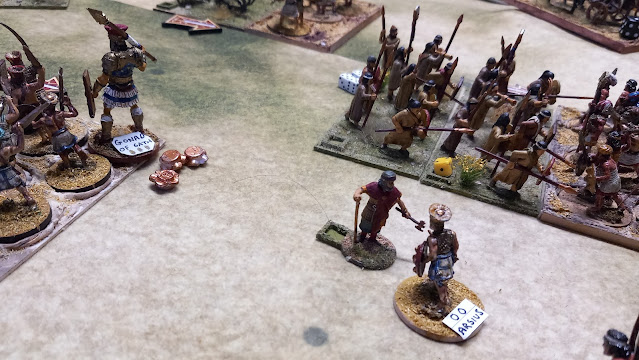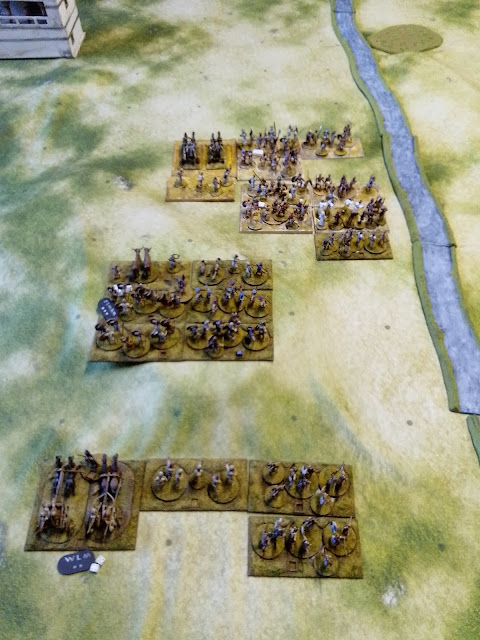We're three weeks into our Bronze Age campaign, the first two games of which have been recorded by the blind poet Humor. These, so called, poems make up the Testiad, and largely concern the exploits of the eponymous hero Testes. No bias there then!
As it happens, Testes died in the second battle and Humor failed to record the third (apparently even Philistines can forget their mobile phone), bringing the Testiad to an abrupt end.
Hence, this is probably a good point to take a step back and provide the players with a bit of context, as well as a battle report.
Our Bronze Age project was conceived during lockdown, after an initial suggestion from Uriah the Hittite. As Uriah divides his residence time between the UK and Cyprus, it seemed only natural to base the campaign in Cyprus - Alashiya as it was then known.
We set the campaign in the Late Bronze Age and it was unapologetically designed to use our respective figure collections. Hence, Sea Peoples and Hittites were to be the protagonists.
The origins and identity of the various Sea Peoples are much debated and largely unproven. However, some argue that they originated in the Aegean, including Greece and Western Anatolia. This places them nicely in a position to interact with the Hittites and Alashiya in a 'what if' setting.
So, whilst our campaign is fictional, the Hittites did have an interest in Alashiya, apparently invading at least once. Elements of the Sea Peoples are also believed to have raided Alashiya. For instance, in the renowned Armana letters, the Egyptian pharaoh, Akhenaten, accused the king of Alishiya of being complicit in raiding, to which the king replied;
'Why my brother, do you charge me with this? I have done nothing of the kind! These men from Lukka seize villages in my own country year after year!'
As the Lukka are usually ranked amongst the Sea Peoples, this gives us all the justification we needed. Hence, our campaign features a Hittite garrison on Alishiya, presumably there to control the production copper of which Alashiya is famous. This unfortunate garrison will then be subject to the depredations of a raiding confederation of Sea Peoples.
Our original intention was to game this using a suitable set of skirmish rules, such as 'Lion Rampant'. However, emerging from lockdown, we discovered that we had acquired far more miniatures than we could possibly use. Fortunately, the recent publication of 'Midgard', an army levelm set of rules, with its emphasis on legendary and heroic warfare, proved to be just what we needed. The rules even include lists for the Trojan war, which served as a useful starting point.
With the rules sorted, all we needed now was a campaign format. I decided to go with a system that would generate a finite number of scenarios, with a suitable narrative background.
The map consists of four areas, the limits of which are defined by the Hittite / Cypriot city and the Black Ships, which also serve as the campaign objectives. Between these we have an area into which the Sea Peoples will raid and an area in which the Hittites will push them back towards their ships. Each area has four possible scenarios (with some twists) and is determined by which side has the campaign advantage (i.e. whoever won the last battle). To advance to the final objective an army must have played three of the scenarios in the adjacent area (not necessarily won) and have the advantage. A game at one of the objectives will constitute the campaigns grand finale. This will give a minimum of four games and a maximum of seven.
The 'Midgard' rules use a system of reputation points to decide the winner of a battle. For the purposes of the campaign, the reputation scored at the end of a game (including negative totals) is banked and the accumulated total, at the end of the grand finale, decides the campaign winner.
The campaign currency (aka reputation tokens) are oxhide ingots. These oxhide shaped copper ingots were common in the Bronze Age and are seen in Egyptian and Minoan frescoes, and extant examples are known from period ship wrecks.
 |
| A copper ingot |
 |
| Minoan tribute bearer in an Egyptian frescoe. |
In addition to an army's Reputation, scored as per the rules, we also award or deduct reputation tokens to individual heroes. Thus, at the end of the campaign, we will know which hero was the most heroic. To avoid confusion we use a different set of tokens for these, shaped like Greek pithoi (or amphorae as our resident Philistine insists on calling them).
The Story so Far
The campaign started with the Sea Peoples (an alliance of Peleset and Ekwesh) raiding into Hittite territory and attempting to draw the Hittites into battle by threatening to desecrate one of their sacred stones. The scenario was inspired by the 'Lion Rampant' scenario 'Hold on Tight', in which victory points are scored by holding a central objective. However, in this case the objective was a standing stone, based upon a so-called healing stone near Limassol.
The game saw the Hittites take up tactically advantageous positions, in a typical wargame style, which allowed the Sea Peoples to notch up Reputation, each turn, by staying in contact with the stone. (By contact I mean the Hero Testes p*ssing on it). A close game where Hittite gains in combat were offset by copious amounts of urine, resulting in a victory for the Sea Peoples.
Game Two saw the Sea Peoples caught, on the march, after a raid into Hittite territory. For this game the Sea Peoples had four extra units, classed as Hordes, containing a mixture of slaves, livestock and escorting warriors. The objective was to escort these units across the table to exit by the opposite table edge. A tough mission as they counted as both Brittle and Reluctant. Inevitably, the Sea Peoples were surrounded and defeated - although Testes contingent did forge ahead and leave his Ekwesh allies to face the Hittites on all sides. That said, he did die in battle - serves him right, the bounder.
Game Three
The third game saw the Hittites pushing the Sea Peoples back towards the ships. The Sea Peoples had the option to take up various defensive positions with a reduced force or camp on the plains with their whole force. The newly promoted Peleset leader, Gonad, opted to camp with the full army.
 |
| Gonad of Gath - a strapping fellow |
For their part, the Hittites had the option of a night attack, catching the Sea Peoples in camp, or a dawn attack allowing them time to decamp. Wary of possible confusion and disorganisation likely in a night attack, the Hittites chose a more cautious dawn attack.
 |
| The Ekwesh deploy to the left of the Peleset, with their left echeloned back to avoid being outflanked |
 |
| The Peleset take up position on the right, dangerously close to a wood. |
 |
| As dawn breaks, the Sea Peoples are seen to be largely in place, with only Pyjamarama's Ekwesh deployed forward of the main position. |
 |
| The Hittites immediately put pressure on the Peleset, driving off their chariots and archers with massed missile troops and chariot runners. |
 |
| On the left, Hittite archers prove an annoyance for the advanced Ekwesh. |
 |
| The Hittites seize the initiative, putting Gonad's Peleset under pressure and gaining early advantage in Reputation. The Hittites are clearly ahead at this point. |
 |
| Pyjamarama is similarly assailed but holds on tight. |
 |
| Until the inevitable failed 'Risk to Heroes' test, spending Reputation for a reroll. |
 |
| A wounded Pyjamarama gamely charges in gaining more Reputation. The Hittites win the melee but the loss of a couple of units empties their vessel of Reputation and its game over. |
After a surprise win, the advantage is once again with the Sea Peoples. If they can win the next one it will be on to the city for the grand finale!
So that's where we stand going into game four. Hopefully, our resident Philistine will remember his phone this time and I can hand back reporting duties to Blind Humor with the accompanying bad poetry.
























































